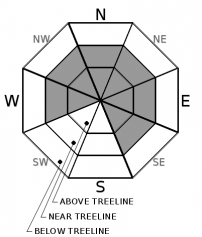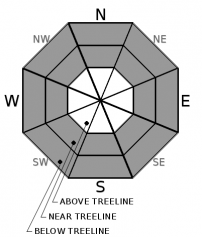| Sunday | Sunday Night | Monday | |
|---|---|---|---|
| Weather: | Partly cloudy then becoming cloudy. Chance of snow in the morning, then snow in the afternoon. Snow levels below 7000 feet. Chance of precipitation is 90%. | Mostly cloudy then becoming partly cloudy. Snow likely in the evening, then slight chance of snow after midnight. Snow levels below 7000 feet. Chance of precipitation is 65%. | Mostly cloudy. Chance of snow. Snow levels below 7000 feet. Chance of precipitation is 50%. |
| Temperatures: | 39 to 44 deg. F. | 14 to 20 deg. F. | 26 to 31 deg. F. |
| Mid Slope Winds: | South 20 to 35 mph with gusts to 50 mph. | South 15 to 25 mph. Gusts up to 45 mph decreasing to 35 mph after midnight. | East around 15 mph in the morning becoming light. Gusts up to 25 mph. |
| Expected snowfall: | 70% probability of 3 to 7 inches. 30% probability of 7 to 10 inches. | SWE = 0.30-0.55 inch. | 70% probability of 1 to 2 inches. 30% probability of 2 to 4 inches. | SWE = up to 0.25 inch. | up to 1 inch. | SWE = less than 0.10 inch. |
| Sunday | Sunday Night | Monday | |
|---|---|---|---|
| Weather: | Partly cloudy then becoming cloudy. Chance of snow in the morning, then snow in the afternoon. Snow levels below 7000 feet. Chance of precipitation is 95%. | Mostly cloudy then becoming partly cloudy. Snow likely. Snow levels below 7000 feet. Chance of precipitation is 70%. | Mostly cloudy. Chance of snow. Snow levels below 7000 feet. Chance of precipitation is 50%. |
| Temperatures: | 36 to 41 deg. F. | 12 to 17 deg. F. | 22 to 27 deg. F. |
| Ridge Top Winds: | South 35 to 55 mph with gusts to 90 mph decreasing to 30 to 45 mph with gusts to 70 mph in the afternoon. | Southwest 25 to 35 mph with gusts to 55 mph becoming south 15 to 25 mph with gusts to 40 mph after midnight. | East around 15 mph with gusts to 30 mph. |
| Expected snowfall: | 70% probability of 4 to 8 inches. 30% probability of 8 to 12 inches. | SWE = 0.30-0.55 inch. | 70% probability of 1 to 2 inches. 30% probability of 2 to 4 inches. | SWE = up to 0.25 inch. | up to 2 inches. | SWE = less than 0.10 inch. |



























